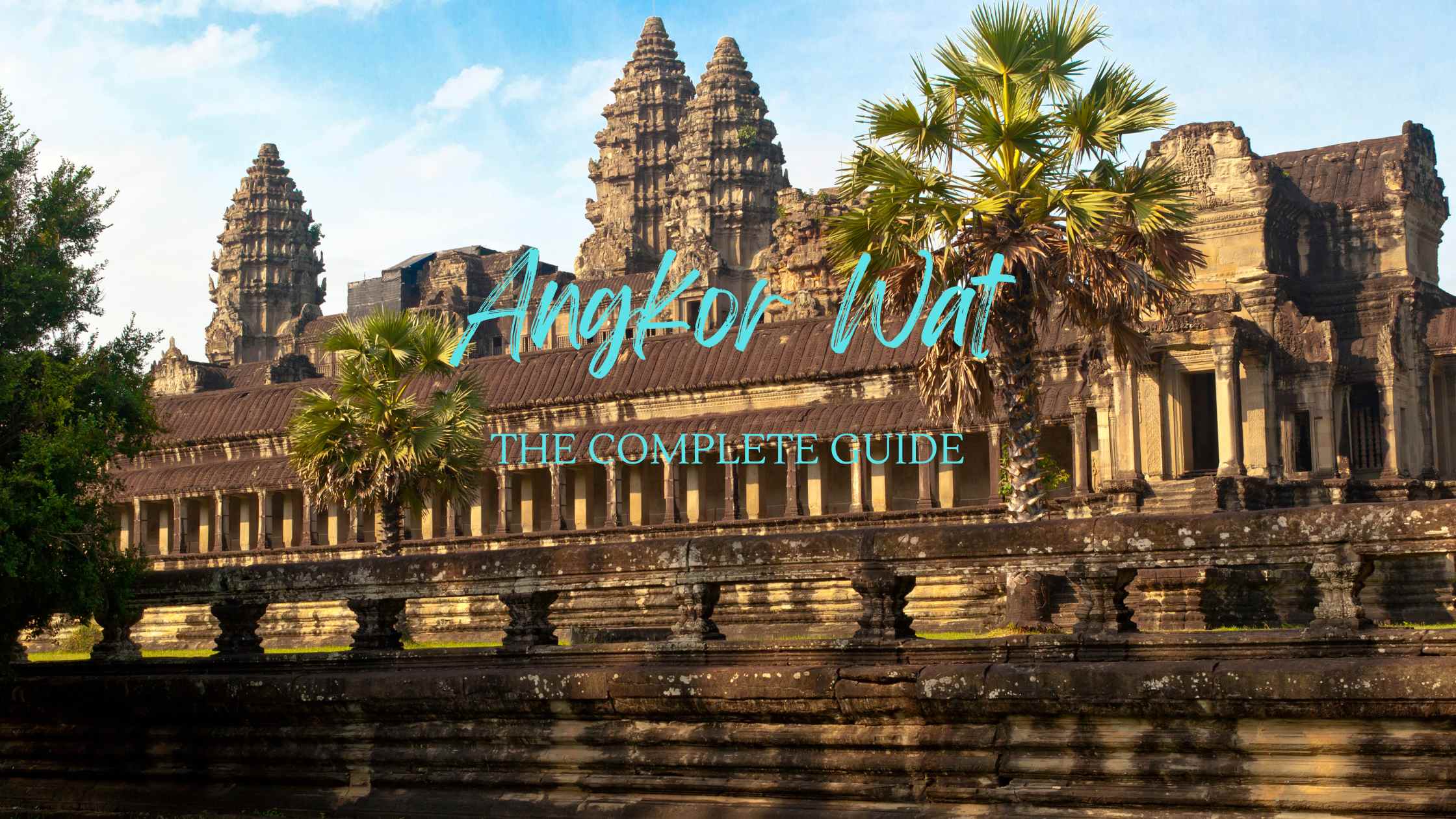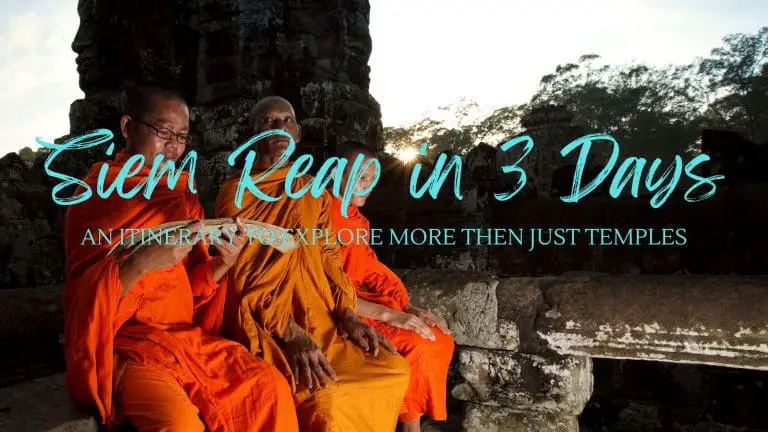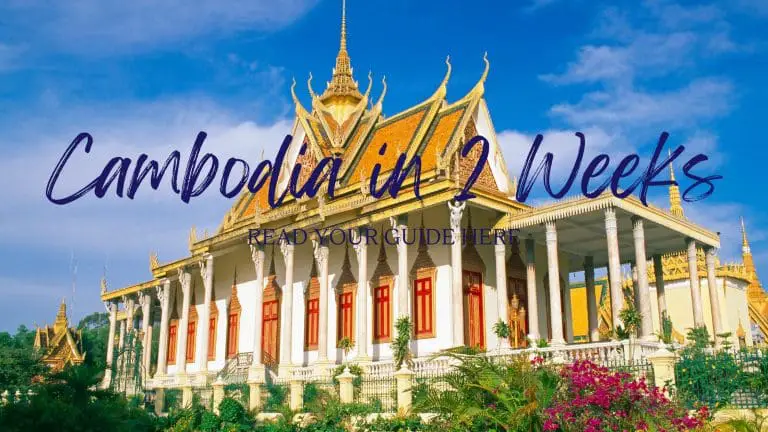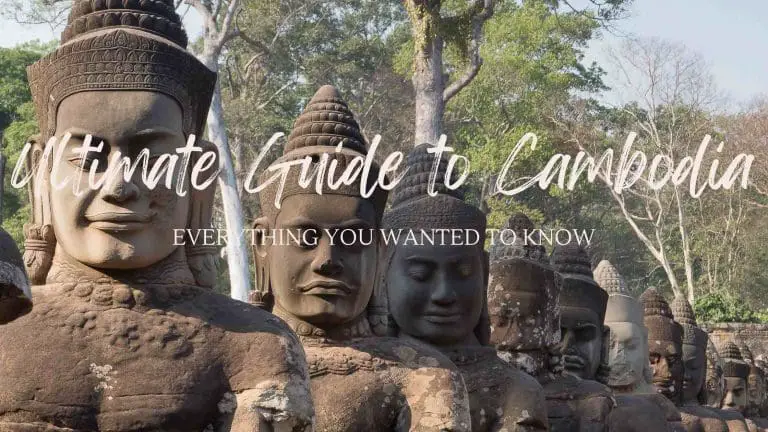Complete Guide to Angkor Wat Temple: A Comprehensive Exploration
Welcome to the complete guide to Angkor Wat temple, where history and adventure meet. This guide will take you through the heart of Cambodia, showcasing the magnificent Angkor Wat and its surrounding temples. With an array of intricately carved relics set against lush landscapes. A trip to Cambodia promises to be an unforgettable journey.
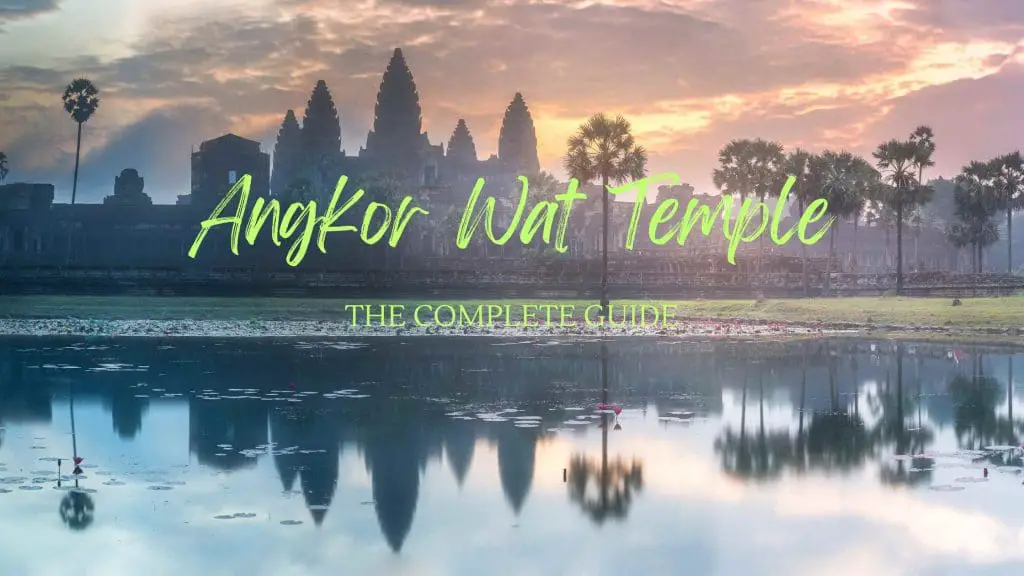
Planning your trip is the first step in unlocking the mysteries of the ancient world. From navigating the nitty gritty of ticket purchases to choosing the best Angkor Wat tours. This guide provides all the essential information. Whether you’re captivated by the famous temples like Preah Khan and Banteay Srei or the serene beauty of Neak Pean. The complete guide to Angkor Wat temple is your key to exploring these ancient wonders.
Every visitor’s experience is unique, but with tips on when to capture the famous sunrise, how to respect the cultural heritage, and where to find the best viewpoints. This complete guide to Angkor Wat temple ensures your adventure is nothing short of magical. Get ready to explore the architectural marvels. From the majestic Terrace of Elephants to the serene waters of Srah Srang. We dive deep into the heart of Krong Siem Reap.
Unveiling the Wonders of Angkor Wat
The complete guide to Angkor Wat temple is your passport to the past. As the sun rises over the horizon, the silhouette of Angkor Wat cuts a striking figure against the morning sky. This moment alone makes planning your trip worthwhile.
But Angkor Wat is more than just a beautiful sunrise. It’s a symbol of Cambodia’s heart and soul. This complete guide to Angkor Wat temple invites you to explore beyond the main sanctuary. It gives you a chance to discover hidden gems and stories that have stood the test of time.
The Historical Tapestry of Angkor Wat
Angkor Wat’s history is as captivating as its architecture. Built in the 12th century, it was initially a Hindu temple dedicated to the god Vishnu. This complete guide to Angkor Wat temple walks you through its transformation into a Buddhist temple. Reflecting the changing religious landscape of Cambodia.
The walls of Angkor Wat are adorned with stories, each carving a window into the past. Through this complete guide to Angkor Wat temple, you’ll learn about the empire’s rise and fall and the temple’s significance in Cambodian culture.
Architectural Marvels of Angkor Wat and Its Complex
Angkor Wat is an architectural masterpiece. Built in the 12th century, its layout symbolizes the Hindu cosmology. With the central tower representing Mount Meru, the center of the universe. This complete guide to Angkor Wat temple unveils the precision and skill of ancient Khmer architects. From the expansive moat that mirrors the oceans to the intricate bas-reliefs depicting mythical battles and legends.
Surrounding Angkor Wat, the temple complex houses myriad marvels. Each structure tells a part of the grand tapestry that is Cambodia’s history. Through this complete guide to Angkor Wat temple, you’ll journey through corridors of time. Exploring other architectural wonders that make up this UNESCO World Heritage site.
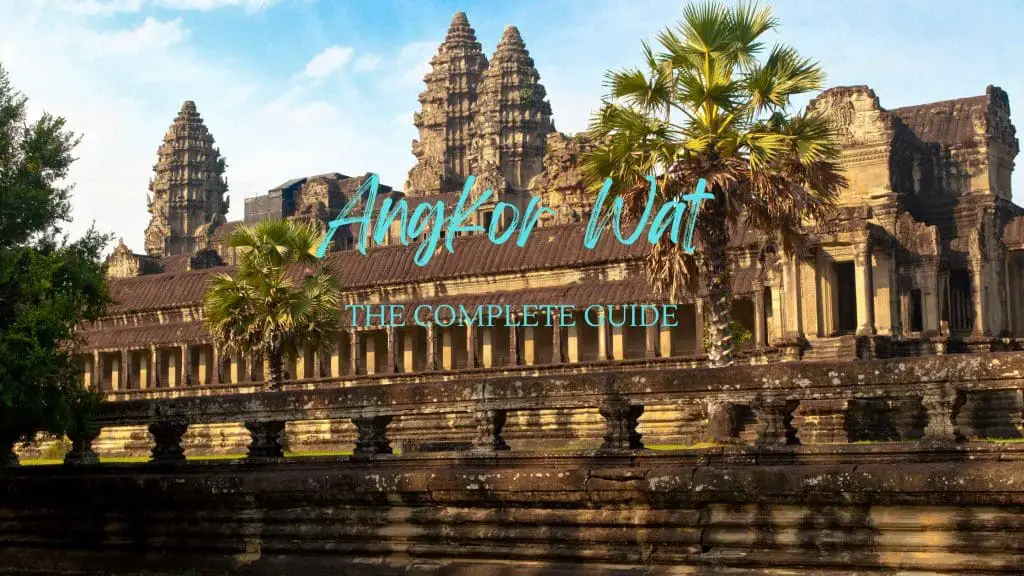
Vital Planning for Your Visit
Before embarking on your adventure, understanding the basics is crucial. The wet season may bring heavy rains but also fewer crowds and lush landscapes. This complete guide to Angkor Wat temple details everything you need for a seamless experience. Ensuring your visit is as enriching as it is enjoyable.
Best Time of Year to Witness the Grandeur of Angkor Wat
The complete guide to Angkor Wat temple suggests visiting during the dry season for the best experience. Not only will you witness the famous sunrise without the hindrance of rainclouds. But you’ll also have the opportunity to explore the grandeur of Preah Khan, Pre Rup, and Banteay Srei under clear skies. Angkor Wat tours during this time offer a magical glimpse into the past.
When to Capture the Perfect Sunrise at Angkor Wat
Catching the perfect sunrise at Angkor Wat is a highlight for many travelers. This complete guide to Angkor Wat temple recommends arriving early, between 5:00 and 5:30 AM, to secure a good spot. The sight of the first light illuminating the temple towers is truly unforgettable.
Moreover, the complete guide to Angkor Wat temple advises exploring the temple’s eastern side post-sunrise. The soft morning light provides a unique perspective, perfect for photography enthusiasts and those seeking a quiet moment of reflection.
Understanding Angkor Temple Tickets
Securing your entrance to this historic site is a key part of planning your trip. This complete guide to Angkor Wat temple breaks down everything you need to know about ticket options and costs.
How to Secure Your Entrance Pass

To visit the temples, purchasing a pass from the official ticket office is required. You can also purchase your tickets online from the official government website. The complete guide to Angkor Wat temple outlines the options. A one-day pass for 37 USD, a three-day pass for 62 USD, or a seven-day pass for 72 USD, offering flexibility for your exploration.
This complete guide to Angkor Wat temple emphasizes buying your ticket a day before your visit. Doing so allows you to experience the famous sunrise at Angkor Wat without any hassle the following morning.
Navigating Through the Mystical Temples
The Angkor temple complex, a UNESCO World Heritage site, lies in the heart of Southeast Asia. This complete guide to Angkor Wat temple invites you on a journey through the mystical temples scattered across Siem Reap Province, each telling its own story of a city that once thrived as the largest pre-industrial city in the world.
Introduction to the Iconic Temples
The Majesty of Angkor Thom
Angkor Thom, the last capital of the Khmer Empire, stands as a testament to Cambodia’s grand history. This complete guide to Angkor Wat temple takes you through its majestic gates and into the heart of a city designed with precision and care, where every stone tells a story of might and spirituality.
Within its walls, the Bayon Temple, with its serene and enigmatic faces, offers a glimpse into the past ruler’s vision of harmony and power. This complete guide to Angkor Wat temple ensures you don’t miss out on the intricacies that make Angkor Thom a masterpiece of Khmer architecture.
The Enigmatic Faces of Bayon
The Bayon Temple, located at the center of Angkor Thom, is renowned for its towering faces, each bearing a serene smile. This complete guide to Angkor Wat temple reveals the symbolism behind these faces, thought to represent compassion and wisdom, guiding visitors through a spiritual journey in the heart of Cambodia.
Exploring Bayon’s narrow corridors and discovering its detailed bas-reliefs is an adventure in itself. The complete guide to Angkor Wat temple highlights the best paths to take, ensuring you experience the full majesty of Bayon and its historical significance.
The Tree-Enshrouded Ta Prohm
Ta Prohm, famously known as the Tomb Raider temple, is a spectacle of nature reclaiming man’s creation. This complete guide to Angkor Wat temple takes you on a walk through its ruins, where massive trees intertwine with ancient stones, creating a scene that sparks the imagination and transports you to another era.
The harmony between nature and architecture at Ta Prohm offers a unique photography opportunity and a moment to reflect on the impermanence of human endeavors. Through this complete guide to Angkor Wat temple, you’re encouraged to explore its hidden corners and appreciate the beauty in decay.
The Mysterious Preah Khan
Preah Khan, a temple complex that once served as a bustling city, school, and Buddhist monastery, is enveloped in mystery. This complete guide to Angkor Wat temple invites you to wander its halls, where trees growing out of ruins create a hauntingly beautiful landscape.
In the heart of the Angkor temple complex, Preah Khan stands as a reminder of the Khmer Empire’s might and spiritual depth. This complete guide to Angkor Wat temple guides you through its extensive grounds, ensuring you experience the tranquility and historical richness of this less-traveled gem.
The Intricate Banteay Srei
Banteay Srei stands out in the Angkor complex with its detailed carvings and pink sandstone walls. This 10th-century temple, often called the ‘Jewel of Khmer Art’, showcases the sophisticated craftsmanship of the ancient Khmer builders. Its intricate reliefs depict scenes from Hindu mythology, making it a unique part of the complete guide to Angkor Wat temple.
Unlike the towering temples of Angkor Wat, Banteay Srei’s charm lies in its compact size and the extraordinary detail of its lintels and pediments. This makes it an essential stop for anyone looking to explore the depth of artistry in the Angkor complex. The temple’s preservation allows visitors to step back in time and admire the ancient world’s beauty.
The Serene Srah Srang
The Srah Srang reservoir, part of the complete guide to Angkor Wat temple, offers a tranquil escape within the ancient city. Originally constructed in the 10th century, this reservoir served as a bathing pool for the Khmer royalty. Today, its serene waters reflect the early morning light, creating a peaceful setting for reflection and meditation.
Visitors are drawn to Srah Srang for its quiet beauty and the chance to witness local life unfold at dawn. The reservoir’s embankment, adorned with guardian lions and naga balustrades, adds to its charm, making it a picturesque spot for relaxation after exploring the bustling temples nearby.
The Sunset View at Phnom Bakheng
Phnom Bakheng is famed for its sunset views, offering one of the best photo opportunities in the Angkor complex. As the day ends, visitors climb to the temple’s summit to catch the spectacular sight of the sun dipping below the horizon, with Angkor Wat in the distance. This moment captures the essence of the complete guide to Angkor Wat temple, blending natural beauty with ancient wonder.
However, its popularity means it can get crowded. To secure a good spot, it’s advisable to arrive early and be patient. The climb and the wait are worth it when the sky explodes into colors, offering a breathtaking backdrop against the silhouette of Angkor Wat. This experience is a must-do for photographers and romantics alike.

The Lesser-Known Charms of Banteay Kdei and Ta Som
Banteay Kdei and Ta Som are gems within the Angkor complex that offer a glimpse into the quieter side of Khmer architecture. Banteay Kdei, known as the ‘Citadel of Monks’, contains vast halls and serene faces carved into stone, inviting exploration. Ta Som, with its famous strangler fig tree engulfing an eastern gopura, offers a unique photo opportunity and a moment of awe in the complete guide to Angkor Wat temple.
These temples, less visited than their grander neighbors, allow for a more intimate experience with the ancient world. Walking through their less crowded corridors, one can easily imagine the bustling life that once filled these spaces. Their underrated beauty adds depth to the journey through Angkor, making them essential for anyone seeking a comprehensive exploration.
Crafting Your Angkor Wat Itinerary
Planning your visit is crucial to fully explore Angkor Wat and capture the perfect sunrise. Whether you’re there for a day or longer, prioritize the iconic temples but leave room for the unexpected. This approach allows you to immerse in the grandeur of Angkor Wat, marvel at the faces of Bayon, and wander through the tree-entwined ruins of Ta Prohm. Your journey through the ancient city will be unforgettable with a well-crafted itinerary.
Single Day Exploration: The Must-See Temples

A single day in the Angkor complex demands strategic planning to experience its highlights. Starting early at Angkor Wat to watch the sunrise sets a magical tone for the day. Next, the ancient city of Angkor Thom, with the Bayon at its center, offers a contrast with its serene stone faces. Finally, the atmospheric Ta Prohm, where nature and architecture intertwine, completes the essential trio. This itinerary covers the best of Southeast Asia’s spiritual and architectural heritage located in Siem Reap province.
Though challenging, a one-day tour encapsulates the essence of the Angkor complex. It offers a glimpse into the richness of the Khmer Empire and leaves many in awe of what has been preserved. The journey through these sacred spaces provides a profound understanding of Cambodia’s heart and soul, making it a cornerstone of the complete guide to Angkor Wat temple.
Multi-Day Adventure: Diving Deeper into the Ancient City
For those with more time, a multi-day adventure allows a deeper exploration of the Angkor complex, the capital city of the Khmer Empire. Beyond the must-see temples, days can be filled visiting lesser-known sites like Banteay Srei, known for its intricate carvings, and the serene Preah Khan. Each temple offers a unique perspective on the ancient city’s life, from its grandeur to its daily routines.
Spending multiple days in Angkor provides the opportunity to witness the temples at different times of the day, capturing the changing light and atmosphere. This pace also allows for moments of reflection amidst the ruins, connecting visitors to the past in a personal way. A multi-day itinerary is essential for those looking to fully embrace the historical and spiritual depth of Angkor, making it a cornerstone of the complete guide to Angkor Wat temple.
Beyond the Temples
Exploring Angkor Wat is an unforgettable journey, but the adventure doesn’t end with the temples. The region surrounding these ancient wonders, including the vibrant town of Siem Reap, offers its own array of experiences. From bustling markets to serene rice fields, the area invites visitors to immerse themselves in Cambodian culture and hospitality. This chapter of the complete guide to Angkor Wat temple encourages travelers to discover the beauty that lies beyond the temple walls.
Discovering Siem Reap: The Gateway to Angkor Wat
Siem Reap serves as the gateway to the temples of Angkor, offering a mix of modern comforts and traditional charm. The town is a hub for travelers, with options for every budget and taste. Hiring a tuk-tuk driver for temple tours provides a personal touch and insights into the area. Siem Reap’s markets, restaurants, and galleries also offer a chance to experience local arts, cuisine, and crafts. This vibrant town is an essential part of the complete guide to Angkor Wat temple, providing a base from which to explore the ancient wonders and beyond.
Comfortable Stays: Best Hotels in Siem Reap
Finding the right place to stay in Siem Reap can enhance the Angkor Wat experience. The town offers accommodations ranging from luxurious resorts to charming guesthouses, many overlooking the tranquil Tonle Sap Lake. These hotels provide a peaceful retreat after a day of temple exploration, offering comfort, excellent service, and often, picturesque views. Choosing the right hotel can add an extra layer of enjoyment to your journey, making it a key consideration in the complete guide to Angkor Wat temple.
Many hotels also offer helpful services, such as arranging tours to Angkor Wat and other nearby attractions. This convenience ensures that visitors can maximize their time exploring the ancient sites and experiencing the local culture. With the right accommodation, your stay in Siem Reap becomes an integral part of the adventure, blending relaxation with exploration.
Siem Reap Beyond Temples: What Else to Do
While the temples are the main draw, Siem Reap offers much more to explore. Cultural experiences like traditional Khmer dance performances and cooking classes provide insights into Cambodian traditions. Adventure seekers can venture into the countryside on bike tours, witnessing the daily life of rural communities. These activities enrich the journey, offering a broader understanding of Cambodia beyond its ancient temples.
Visiting the floating villages on Tonle Sap Lake offers a unique perspective on local life, highlighting the community’s resilience and adaptation to the lake’s seasonal rhythms. These experiences, combined with the temples’ exploration, create a well-rounded adventure, emphasizing the importance of looking beyond the ruins to understand Cambodia’s heart. This approach is a critical aspect of the complete guide to Angkor Wat temple, ensuring a truly immersive experience.
The Ethereal Beauty of Pre Rup during Sunset
As part of the complete guide to Angkor Wat temple, Pre Rup stands out for its breathtaking sunset views. Visitors often climb the steep steps to reach the top. From there, they witness the sky’s colors change over ancient stones. It’s a moment where time seems to stand still.
Though not a spot for sunrise like Angkor Wat, Pre Rup’s sunset offers a unique serenity. The temple’s brick and laterite construction glows under the fading light, creating a picturesque scene. It’s a must-see for those exploring the Angkor Wat complex.
Practical Tips for an Unforgettable Journey

In this complete guide to Angkor Wat temple, remember to bring food and drink during your visit. The Angkor Wat complex is vast, and exploring can take hours. Staying hydrated and energized is key to enjoying your journey through this ancient wonder.
How to Get to Angkor Wat: Your Guide to Reaching this Ancient Wonder
Reaching Angkor Wat is an adventure in itself. Many choose a guided tour for convenience and insight. This option often includes transportation, making it easier for those visiting the park for the first time.
For independent travelers, renting a bike or hiring a tuk-tuk are popular choices. These methods offer flexibility to explore at one’s own pace. Whichever way you choose, arriving early is recommended to witness the magical sunrise at Angkor Wat.
Dressing Appropriately for a Temple Visit
In the complete guide to Angkor Wat temple, dressing respectfully is crucial. The temples in the Angkor Archaeological Park are sacred. Wearing clothes that cover shoulders and knees is a sign of respect. It also ensures comfort while navigating the dense jungle surrounding the temples.
Respectful Attire: Ensuring Cultural Sensitivity
When visiting temples built in the 11th century, like those in Angkor Wat, cultural sensitivity is key. Clothing should be modest, covering the body adequately. This not only respects the local customs but also protects you from the sun and insects.
Some temples, entwined with roots of ancient banyan trees, are mystical sites. Here, the connection between nature and spirituality is palpable. Dressing respectfully enhances this experience, aligning visitors with the serene and sacred atmosphere of Angkor Wat.
Avoiding Scams and Ensuring a Smooth Trip
In the complete guide to Angkor Wat temple, being aware of scams is important. While most visits are trouble-free, knowing common tricks can help. Always buy tickets from official sources and be wary of unsolicited guides.
Strategies to Navigate Common Tourist Traps
Travel insurance is a smart strategy against potential issues. It can provide peace of mind, covering unexpected events during your trip. This is essential for a smooth journey, especially when exploring foreign lands like the temples of Angkor Wat.
In addition, always agree on prices before services, especially with tuk-tuks and guides. This clear communication helps avoid misunderstandings and ensures a pleasant visit to Angkor Wat. Remember, sunrise at Angkor Wat is a popular time, so plan accordingly to avoid the crowds.
Exploring Angkor Wat Responsibly
The complete guide to Angkor Wat temple emphasizes responsible travel. With over 2 million visitors each year, the famous Angkor Wat and surrounding temples face pressure. Tourists can help by staying on marked paths and respecting the site’s rules.
Minimizing waste and using water bottles that can be refilled are simple yet effective ways to reduce impact. These actions ensure Angkor Park remains a treasure for future generations. This guide encourages visitors to escape the crowds responsibly, preserving the site’s integrity.

Sustainable Tourism: How to Visit Angkor Wat with Respect
Visiting Angkor Wat with respect means understanding its significance. This complete guide to Angkor Wat temple suggests avoiding over-touristed spots during peak hours. Instead, explore lesser-known areas.
Remember, only 300 people are allowed to climb the main temple at sunset to protect the structure. Planning your visit around these rules not only ensures a better experience but also contributes to the site’s preservation. This approach embodies sustainable tourism, respecting both the monument and its visitors.
Supporting Local Communities during Your Visit
The complete guide to Angkor Wat temple encourages supporting local communities. Visiting during the wet season can spread tourism benefits throughout the year. This period offers a different perspective of the temples, with lush landscapes and fewer crowds.
Purchasing local crafts and eating at local restaurants are ways to contribute directly to the community. These actions support the economy and allow tourists to connect more deeply with Cambodian culture. It’s a win-win for both visitors and residents.
Angkor Wat FAQs Addressed
This complete guide to Angkor Wat temple aims to answer your questions. From ticket prices to transportation, we’ve got you covered.
Ticket Pricing, Validity, and Purchase Points
Tickets to Angkor Wat can be bought at the official ticket center. They come in one-day, three-day, and seven-day options, catering to different itineraries. Prices vary, so check the latest rates before your visit.
Remember, tickets purchased after 5 PM allow for a same-day sunset visit plus entry for the following day. This tip can maximize your exploration time, making every moment at Angkor Wat count.
Best Modes of Transportation Within the Archaeological Park
Inside the park, bicycles and electric bikes offer a leisurely way to move around. They allow visitors to soak in the scenery at their own pace.
From Tuk-tuk Rides to Bicycle Tours
A guided tour is often the best way to learn about Angkor Wat’s history and secrets. Guides can share stories and details that enrich the experience. Plus, they know the best routes for avoiding crowds.
Bicycling through the park allows for a more personal connection with the ancient city. It’s eco-friendly and gives freedom to explore hidden corners. Whether cycling or on a guided tour, visiting the park promises an unforgettable adventure.
Safety Tips for Solo and Group Travelers in Siem Reap
When exploring the ancient city of Angkor, safety comes first. Siem Reap is generally safe, but like any tourist destination, it has its share of petty crimes. Solo travelers should keep their belongings close and be cautious when walking at night. Group travelers, on the other hand, should stick together and avoid splitting up, especially in crowded places. Engaging with local Buddhist monks can also provide insights into respectful conduct and safety tips, enriching your journey through the complete guide to Angkor Wat temple.
Always inform someone about your itinerary, whether you’re heading out for a sunrise at Angkor Wat or venturing into the lesser-known temples. Local authorities and tour guides are valuable resources for the latest safety updates. Remember, staying informed and being mindful of your surroundings are key components of a safe and memorable visit, perfectly complementing your complete guide to Angkor Wat temple experience.

Additional Resources
Finding reliable information is crucial for a fulfilling journey through the temples of Angkor. For those seeking a thorough understanding, downloadable maps and guides are invaluable. These resources provide detailed insights into the temples within the Angkor Archaeological Park, including Bayon and Ta Prohm, known for their enigmatic charm. They also highlight essential tips such as dress code requirements and the significance of the Cambodian flag, ensuring that visitors are well-prepared for their adventure.
Additionally, guides often feature recommendations for sunset spots. Like the serene Pre Rup, and bring attention to lesser-known gems such as Banteay Kdei. With Angkor Wat located at the heart of these explorations, having a map can help you navigate the ancient city of Angkor more efficiently. This ensures that every visitor can fully appreciate the architectural and spiritual depth of these historic sites. Making the complete guide to Angkor Wat temple an indispensable tool for every traveler.
Downloadable Maps and Guides for Angkor Wat
In the quest for a comprehensive exploration, downloadable maps and guides become essential. These resources are meticulously designed to enhance the experience of those embarking on the complete guide to Angkor Wat temple journey. They detail the layout of temples in Angkor, suggest optimal routes, and provide historical context about each significant site. Including the unique stories of Banteay Kdei and the ancient city of Angkor. By offering insights on navigating the vast complex, these guides are instrumental in planning a fulfilling visit.
Moreover, these maps and guides underline practical information such as the Angkor Wat dress code. Also, pinpoint the best spots for witnessing the majestic sunrise or enjoying a tranquil sunset. They serve not just as navigational aids. Also, as comprehensive companions that enrich the understanding of Angkor Wat’s historical and cultural significance. For anyone looking to explore the temples within the Angkor Archaeological Park, such as Bayon and Ta Prohm, these resources are invaluable. Ensuring a well-rounded and enlightening experience aligned with the complete guide to Angkor Wat temple.
Recommended Reading Before You Go
Before diving into the complete guide to Angkor Wat temple, immersing oneself in recommended reading can deeply enrich the experience. Literature on Bayon Temple and various temples tours provides a glimpse into the architectural ingenuity and spiritual depth of these sacred sites. For temple buffs, such reading materials offer a prelude to the marvels they are about to witness, setting a foundation for a more meaningful exploration. Furthermore, understanding the ecological significance of Tonle Sap, and its connection to the ancient Khmer civilization, adds another layer of appreciation for the region’s history and culture.
These readings not only prepare travelers for what they will see but also encourage a deeper reflection on the significance of their visit. They complement the complete guide to Angkor Wat temple, ensuring that visitors are not just sightseers but engaged learners of Cambodian heritage. By delving into the narratives, myths, and historical accounts of Angkor Wat and its surrounding temples, travelers can forge a more profound connection with this ancient wonder, making their journey truly unforgettable.
Concluding Your Journey Through Time
As your journey through the complete guide to Angkor Wat temple comes to a close, reflection on the significance of this incredible temple and its preservation becomes paramount. Angkor Wat stands as a testament to the ingenuity and spirit of the Khmer civilization, boasting the world’s largest religious monument. The smiling faces of Bayon and the intricate carvings across the ancient temples tell stories of a bygone era, inviting visitors to ponder the lives that once thrived here.
Preservation efforts are crucial for ensuring that future generations can also experience the wonder of exploring the temples of Angkor. The tragedy of the Khmer Rouge era, mere kilometres north of this sacred site, reminds us of the resilience of Cambodian culture and the importance of safeguarding its history. As visitors, wearing appropriate attire covering shoulders and knees, and choosing to book a tour that respects the site’s sanctity, are small but significant ways to contribute to the conservation of this heritage. Angkor Wat is the prized temple, not just of Cambodia, but of the world, deserving of our utmost respect and admiration.

